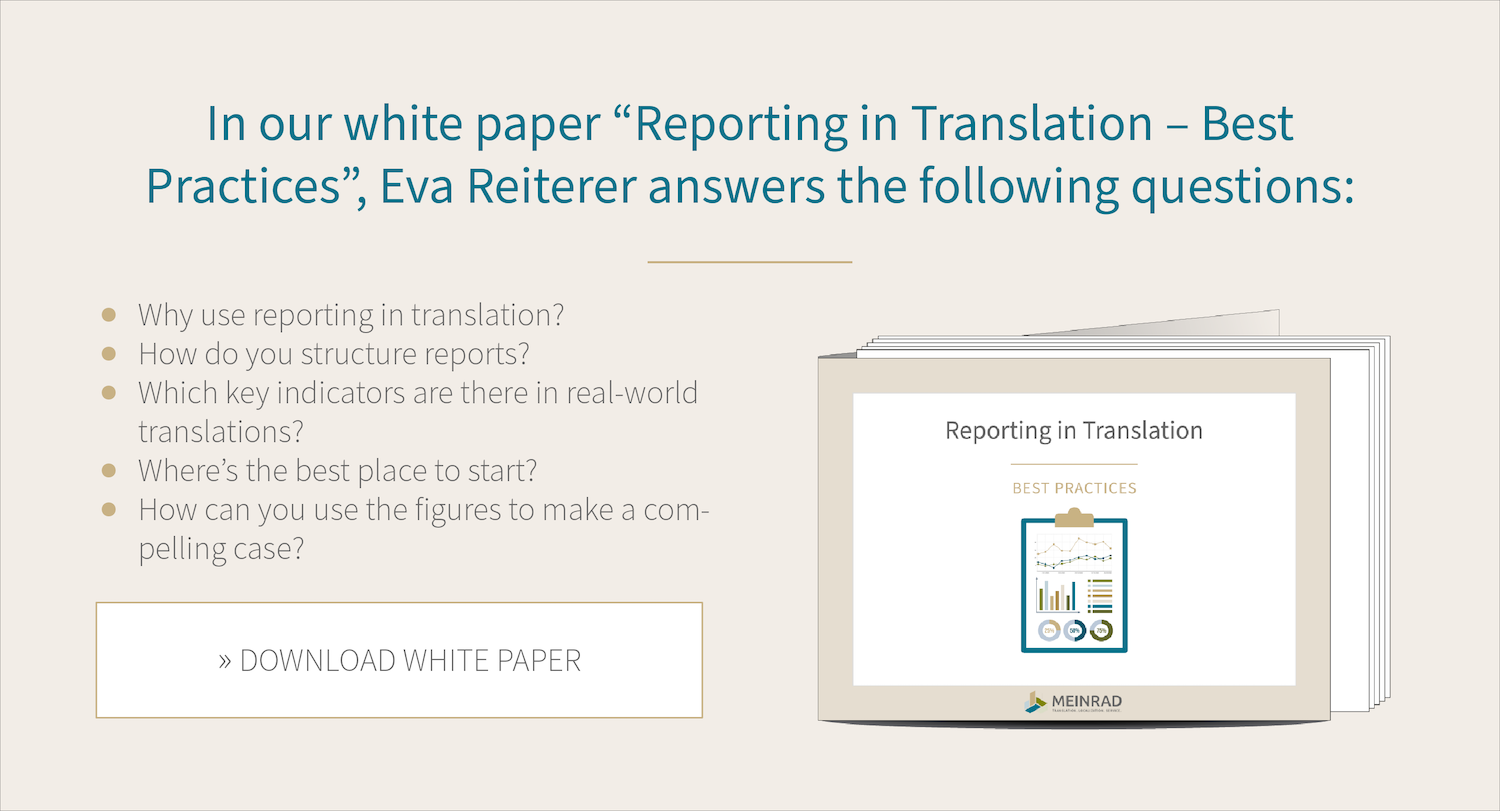
Getting value for money, making savings, ensuring effectiveness – the requirements for translation processes are growing, and with it the demand for key indicators in translation. But what do we mean by reporting in translation? Why do people do it, and what basic knowledge do you need to produce useful reports? We asked our reporting expert Eva Reiterer.
Why are you so passionate about a subject which others in the industry find so daunting?
Because if you do reporting right, you can change things. Change might seem a bit frightening at first, but ultimately it brings progress in life, and that’s exactly what reporting can do in a business or a department: take you to the next level and help you make visible progress. So I really care about it. Reporting is a means to an end, but I also have to admit that I’m a huge numbers and Excel nerd, and obviously that plays into my hands here.
How can you make reporting as exciting for others as it is for you?
When your aim is to produce actual changes, and you recognize that reporting is the way to make that happen, that enthusiasm will come naturally. Because it shows that reporting isn’t simply a demand imposed “from above” where you have to put together some numbers – it’s more of a story that you tell, backed up by the figures. It also helps if you have a guide of some sort to follow: it’s often difficult to take the first steps when you don’t have any idea where to start, but if you can put together a few guiding principles, the ideas will often come very quickly and you’ll enjoy it more and more.
What personal requirements are there? Do you need to be an expert in business administration or controlling?
No, absolutely not! Curiosity is obviously important, and you shouldn’t be shy about asking questions, because it isn’t always easy to get the information you need, especially at the start. It can be hard to believe where some businesses hide information which might be relevant for reporting in translation. In many places each department does its own thing and orders translations from different translation agencies, and that makes it pretty difficult to find the information you need. So at first, you’ll definitely need perseverance. Basic knowledge of Excel or Power BI will help, of course, but it’s not absolutely necessary. Personally, I can recommend the udemy.com courses, which have lots of extremely helpful content on reporting tools at reasonable prices. And something else I think is important in reporting is an eye for the big picture. Just looking at one number isn’t going to help much – you need to explain how the various figures relate to each other and tell the story behind them. With the right storytelling, reporting will really pay off.
What do you mean by “storytelling” in reporting?
One number on its own won’t tell you a great deal. Even if you find data solely from your translation department and show them to your management, they’re bound to ask “And what does that mean?”. That’s no surprise – figures only really gain meaning when you know the story behind them. So when presenting data, you should always include the story and explain the following:
- What does that figure mean?
- Why has the figure changed like that?
- What effects does that have on everyday work in the department and at the business?
- In what way do you want that figure to change?
- How can you make that change happen?
All of that is the storytelling that lots of people talk about. Essentially, it’s just the logical background to the data.
Why do business managers always want to see figures?
Business managers can’t keep track of everything, and they don’t have the time to look closely at the detailed goings-on in each department. If you’re a manager at a business with 10,000 employees, you probably won’t know what makes up a CAT grid or how it affects the quality and cost of translations – and in fact you don’t need to, because you’ll have colleagues who are experts in that area. But managers do have responsibility for the overall picture, so they need to keep on top of things. Figures give people the feeling of having the situation “under control”, even if in reality no one can control or influence absolutely everything. But as a CEO, there’s a different reason why I “want to see figures”: I’d like to encourage my colleagues to join me in thinking about the bigger picture and identifying potential optimizations in their own departments. Rather than shying away from change, they should embrace it. After all, it’s a key element of our company philosophy.
What’s the most important principle in reporting?
For me, the answer is obvious: just go for it! That means having the confidence to give reporting a go, remembering that it’s best to start small and not overstretch yourself. A step-by-step approach is the best way to produce successful reports.
Let’s get down to details. What exactly are you trying to measure in translation management?
Reporting in translations is of course primarily about translation costs, and they can be broken down to be analysed by department, office, language pair, product, file format and/or workflow. The money you save thanks to translation memories, CAT grids and bulk discounts can be measured, and quality indicators such as the results of an LQA (Linguistic Quality Assurance) report or the number of complaints can be helpful too, depending on what you’re trying to do with your report. It should also be straightforward to measure the time your translation staff and technical editors spend working on particular issues or projects.
How can you access the data, and what can you do if you haven’t any?
Ideally, each department will have data you can access. In many cases these data will be stored in various places in a wide range of formats, so you’ll need to take the time to find, make sense of and prepare the data. I can recommend contacting the people you think are responsible for maintaining the data – asking around will usually help you find what you’re looking for. Your translation agency should also have facts and figures you can use. If you really can’t find anything, which will very rarely be the case, you’ll have to take the initiative and start recording data yourself. For instance, you can track your own working hours and analyse how long you take to carry out certain tasks, which will help you calculate how much time you could save if you had a better tool or more capacity. That represents a big step towards uncovering the story behind the numbers.
Where can you get help with reporting?
Most businesses have a controlling department with experts in Excel and Power BI, or you can go online, where you’ll find a range of introductory tutorials on reporting. And when it comes to reporting in translation in particular, translation agencies have expertise that you can tap into. There are also various conferences (such as those organized by tekom) which focus on this issue, so it’s definitely worth taking the plunge and finding out more about reporting by attending one. I gave a talk on this subject at the tekom annual conference in 2021, and you can find a written summary here:
Main image: © MEINRAD



